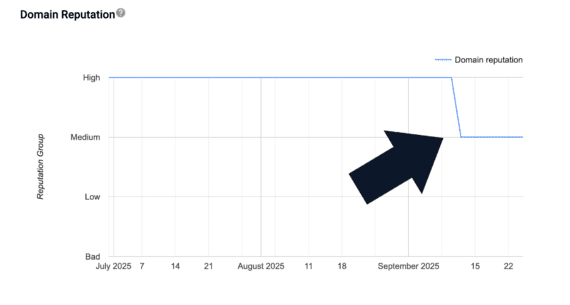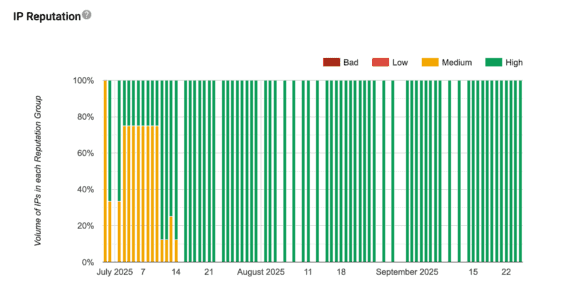Email marketers lose access to two top deliverability indicators on September 30, 2025, when Google deprecates the venerable version 1 of its Postmaster Tools.
The two soon-to-be-gone reports are the IP and Domain Reputation charts. Each offered marketers a simple indication of whether Gmail was labeling messages as spam.
Favored Signals
The IP Reputation chart displayed red, yellow, and green bars, similar to a traffic light, visually indicating whether a sending IP address was well-regarded or not.
Both charts — IP and Domain Reputation — provided uncomplicated email deliverability indicators. If their IP and domain reputation were both “High” in Google Postmaster Tools, senders knew their messages reached Gmail inboxes.
Unfortunately, simplicity sometimes led to complexity. For example, how can a sender restore its domain reputation if it dropped from high to medium?
Finding the answer in Postmaster Tools v1 required visiting other reports such as Authenticated Traffic, Encrypted Traffic, and Spam Rate. A marketer could use the varying tables and charts to hypothesize and then take action.
Identifying an issue was relatively complicated, but experienced email deliverability professionals could usually discover and correct the problem.

A simple interface works well when everything is going smoothly, but what if the domain reputation drops from high to medium? What was the cause?
Compliance Status
In March 2024, Google released version 2 of Postmaster Tools, the first significant change in nearly a decade.
Version 2 included the Compliance Status dashboard, which provides a simple green or red check to indicate whether a sending domain meets Gmail’s email sender guidelines.
“Compliance status” is not as clear as IP and domain reputation, but the dashboard was a helpful start when, say, open and click rates declined. Email deliverability pros could usually discover and correct problems, such as a slow unsubscribe process.
Understanding Compliance
When the IP and domain reputation charts go away on September 30, email marketers will need to understand the Compliance Status dashboard.
One way to approach this report is to categorize it into technical checks and behavioral aspects.
Technical
Six of the Compliance Status report’s requirements focus on a domain’s technical setup: either it complies or not. Green means “meets requirement.”
- SPF and DKIM authentication implemented. Sender Policy Framework (SPF) and DomainKeys Identified Mail (DKIM) prevent spammers from sending unauthenticated messages.
- “From:” header matches SPF and DKIM. An email “From:” header tells the recipient who sent the message. The requirement is to align that header with SPF and DKIM records.
- DMARC authentication implemented. Domain-based Message Authentication, Reporting, and Conformance (DMARC) instructs email servers on how to handle SPF or DKIM failures.
- TLS encryption. The sender employs the Transport Layer Security (TLS) cryptographic protocol to protect message content.
- Forward and reverse DNS records implemented. The sending IP address must have a PTR (reverse DNS) record that resolves to a hostname, and that hostname must have a matching forward DNS (A or AAAA) record pointing back to the same IP.
- One-click unsubscribe implemented. Recipients can easily unsubscribe from the list.
Non-compliance with any of these requirements impacts email deliverability. In Postmaster Tools v1, the errors might have generated a “medium” for domain reputation. In v2, they are clearer.
Behavioral
The remaining two compliance requirements affecting bulk email senders, such as ecommerce marketers, are related to behaviors.
- User-reported spam rate below 0.3%. A passing score is fewer than 0.3% of recipients. The best senders, however, are below 0.1%
- Honor unsubscribes in 48 hours or fewer. Recipients who click an unsubscribe link should stop receiving messages from that specific sending address.
The first of these requirements measures subscribers’ behavior. How many labeled the message as spam?
The second has a technical aspect, but is also dependent on the sender’s practices. For example, a common problem with honoring an unsubscribe is the use of a single sending address.
Imagine a merchant with an email newsletter (content marketing), a promotional list (email marketing), and transactional email automations. If all use the same sending address — e.g., email@example.com — a recipient could unsubscribe from one list but still receive the other two. Gmail would conclude the sender did not honor the unsubscribe.
In short, the depreciation of Postmaster Tools v1 marks the end of an era of sorts. Many email marketers have grown accustomed to logging in and seeing a simple color-coded bar for “Domain Reputation” and “IP Reputation.”
The new version reflects recipient interactions and objective sending standards.






